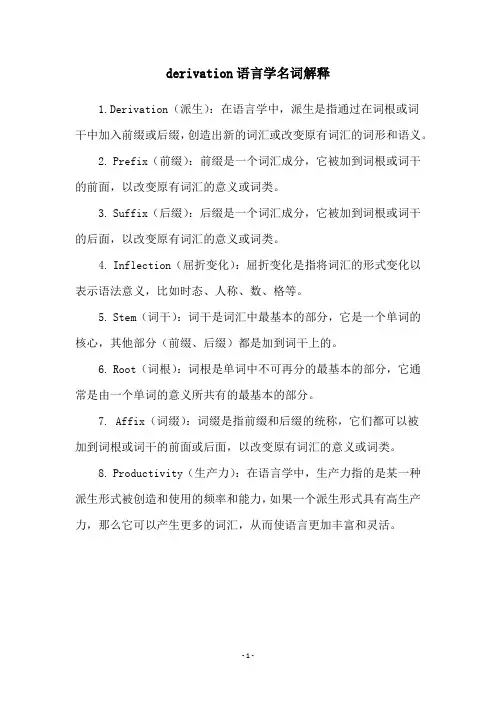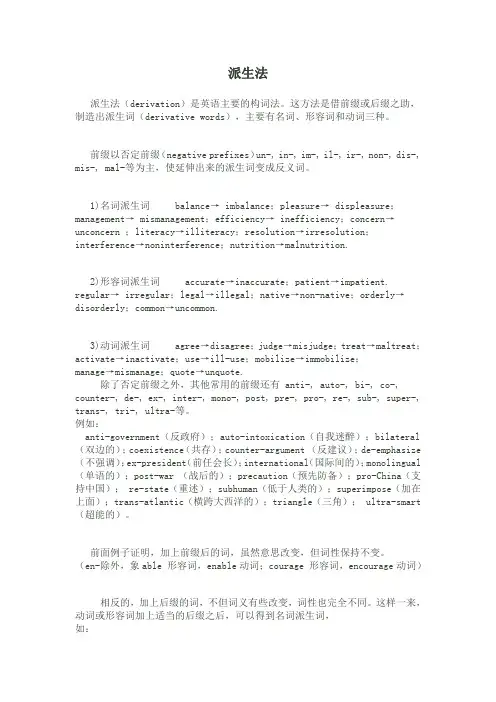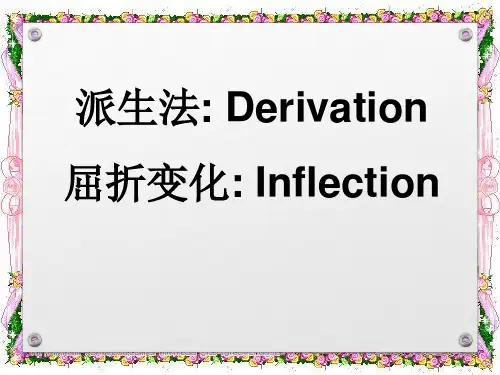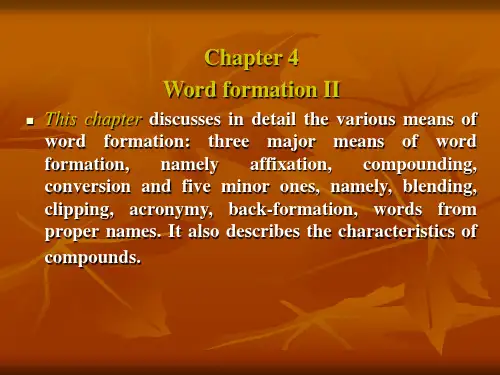词汇学 第4章要点 1 Derivation
Derivation派生法

ge
storage, package, orphanage, marriage, luggage, postage -ure failure, temperature, pressure, pleasure, creature -ity majority, opportunity, infinity -ment argument, statement, achievement, amusement, equipment -ism communism, criticism, internationalism, socialism -ance appearance, entrance -dom kingdom, filmdom, wisdom
规 则 多数以-fy结尾的动词 先把y改成i再加-cation, 少数以-efy或-fy结尾的 动词先去掉y再加action. 有些动词不是加-ion,而 是加-ition, -tion, -ation 或-sion而变成名词,其 中有些词根因读音关系 而发生了变化。
例 词 satisfy/satisfaction, modify/ modification,
engineer, mountaineer
用 法 加于名词后, 女...的 表示阴性 -ician 加在以-ic结尾 ...(专)家, 的名词或形容 表 词上 示 从事...职业 加在名词上, 人 -ist 的人,从事 或 –ize 结尾的 某种...文艺、 动词上,或以学术的人 al结尾的其它 词上 -er 表示从事某 加在动词和名 表 工作的物 词或复合词上 示 表示从事某 加在动词上 物 -or 工作的物
后缀 意义 用法 -hood 表示身份、亲属关系、 加在名词或 性质 形容词上 -ance 表示动作或性质 加在动词上 -th 表示动作、度量、性 由形容词及 质、状态 少数动词构 成 -dom 表示地位、领域、集 加在名词及 体、状态、性质 少数形容词 上
词汇学 第4章要点 1 Derivation

Key Points of “English Lexicology”Chapter 4Word Formation(1)The expansion of vocabulary in modern English depends chiefly on word-formation.The most productive means of word formation are affixation, compounding and conversion.Affixation: 30%-40%, compounding: 28%-30%, conversion: 26%, shortening (clipping and acronymy): 8%-10%, blending and others 1%-5%.Rules themselves are not fixed but undergo changes.There are always exceptions to rules of word-formation.4.1 AffixationAffixation is defined as the formation of words by adding word forming or derivational affixes to bases.According to their position, affixation falls into prefixation and suffixation.1. PrefixationPrefixation is the formation of new words by adding prefixes to bases. Prefixes do not change the word-class of the base but only change its meaning.The major prefixes can be classified into 10 categories by their meaning.1. Negative Prefixes否定前缀Of this group, un- is by far the most productive.2. Reversative or privative prefixes逆反(反向)前缀Prefixes of this group are repetition of most of the first set.3. Pejorative prefixes贬义前缀4. Prefixes of degree or size程度或大小前缀5. Prefixes of orientation and attitude倾向和态度前缀6. Locative prefixes方位前缀7. Prefixes of time and order时间和顺序前缀8. Number prefixes数字前缀9. Conversion prefixes转类前缀10. Miscellaneous prefixes其它前缀2. SuffixationSuffixation is the formation of new words by adding suffixes to bases.The primary function of suffixes is to change the grammaticalfunction of the base, i. e. the change of the word class with a slight modification of meaning.Suffixes can be grouped on a grammatical basis.If we call a suffix a noun suffix, that means when it is added to the base, whatever class it belongs to, the result will be a noun.1) Noun suffixes 名词后缀(1) Denominal nouns 从名词派生的名词Concrete: Noun base→Concrete nounAbstract: Noun base→Abstract noun(2) Deverbal nouns从动词派生的名词V erb base→agential noun (行为者名词)V erb base→abstract noun, denoting action, result, process, state, ect.(3) De-adjective nouns从形容词派生的名词(4) Nouns and adjectives suffixesBase→both nouns and adjectives2) Adjective suffixes(1) Denominal suffixes从名词派生的形容词(2) Deverbal suffixes从动词派生的形容词3) Adverb suffixes-wise表示“方向”、“样子”、“状态”、“在…方面”,现代英语中最后一种意义用得比较多,如:ostrich-wise 像鸵鸟一样地sleep-walker-wise像梦游者一样percetage-wise 就百分比来说calorie-wise 就卡路里来说educationwise 就教育方面来说weatherwise在气候方面taxwise 在赋税方面curriculumwise 就课程方面来说housingwise 就住房问题来看4) V erb suffixes补充:petrify 吓呆petroleum 石油fame 名声,声望infant 婴儿sist, stitut, sta, st=to stand(站立)assist, consist, exist, constituent, persist, stable, establish, obstacle, static, statue, circumstance, distant, ecstasy, prostitute。
derivation语言学名词解释

derivation语言学名词解释
1.Derivation(派生):在语言学中,派生是指通过在词根或词
干中加入前缀或后缀,创造出新的词汇或改变原有词汇的词形和语义。
2. Prefix(前缀):前缀是一个词汇成分,它被加到词根或词干的前面,以改变原有词汇的意义或词类。
3. Suffix(后缀):后缀是一个词汇成分,它被加到词根或词干的后面,以改变原有词汇的意义或词类。
4. Inflection(屈折变化):屈折变化是指将词汇的形式变化以表示语法意义,比如时态、人称、数、格等。
5. Stem(词干):词干是词汇中最基本的部分,它是一个单词的核心,其他部分(前缀、后缀)都是加到词干上的。
6. Root(词根):词根是单词中不可再分的最基本的部分,它通常是由一个单词的意义所共有的最基本的部分。
7. Affix(词缀):词缀是指前缀和后缀的统称,它们都可以被
加到词根或词干的前面或后面,以改变原有词汇的意义或词类。
8. Productivity(生产力):在语言学中,生产力指的是某一种派生形式被创造和使用的频率和能力,如果一个派生形式具有高生产力,那么它可以产生更多的词汇,从而使语言更加丰富和灵活。
- 1 -。
派生法

派生法派生法(derivation)是英语主要的构词法。
这方法是借前缀或后缀之助,制造出派生词(derivative words),主要有名词、形容词和动词三种。
前缀以否定前缀(negative prefixes)un-, in-, im-, il-, ir-, non-, dis-, mis-, mal-等为主,使延伸出来的派生词变成反义词。
1)名词派生词balance→ imbalance;pleasure→ displeasure;management→ mismanageme nt;efficiency→ inefficiency;concern→ unconcern ;literacy→illiteracy;resolution→irresolution;interference→noninterference;nutrition→malnutrition.2)形容词派生词accurate→inaccurate;patient→impatient. regular→ irregular;legal→illegal;native→non-native;orderl y→ disorderly;common→uncommon.3)动词派生词agree→disagree;judge→misjudge;treat→maltreat;activate→inactivate;use→ill-use;mobilize→immobilize;manage→mismanage;quote→unquote.除了否定前缀之外,其他常用的前缀还有 anti-, auto-, bi-, co-, counter-, de-, ex-, inter-, mono-, post, pre-, pro-, re-, sub-, super-, trans-, tri-, ultra-等。
例如:anti-government(反政府);auto-intoxication(自我迷醉);bilateral (双边的);coexistence(共存);counter-argument (反建议);de-emphasize (不强调);ex-president(前任会长);international(国际间的);monolingual (单语的);post-war (战后的);precaution(预先防备);pro-China(支持中国); re-state(重述);subhuman(低于人类的);superimpose(加在上面);trans-atlantic(横跨大西洋的);triangle(三角); ultra-smart (超能的)。
英语构词法-派生法 (3)

•· 2. -or (v.→n.)表示人,置于动词之后。 如:
• competitor director editor operator
·
• 3. -ist表示“从事……者”。 如:
• chemist 化学家 journalist 记者 typist 打字员 scientist 科学家
• 2·. in-, im-, un-, il-, ir-用在形容词前,表示 否定意义。如:
indirect 间接的 incorrect 不正确的 inactive 不活动的 impossible 不可能的
unhealthy 不健康的 unsuccessful 不成功的 unpleasant令人不快的 unfortunate不幸的
派生法: Derivation 屈折变化: Inflection
派生法: derivation
·
• 派生法(derivation)是英语主要的构词法, 用以丰富扩大英语的词汇量。这方法是借 前缀(prefix)或后缀(postfix;suffix)之助, 制造出派生词(derivative words),主 要有名词、形容词和动词三种。
·• 4. -ness (adj.→n.)表示性质,状态。 如:
business darkness weakness
·
• 5. -ment (v.→n.) 表示方式,结果,状 态。 如:
agreement announcement treatment employment encouragement
• 13. pre- 表“在前,预先” • 如; prearrange 预先安置
·
英语词汇学 chapter 4

Names of books
Tradenames
4.1 Affixation or Derivation.(词缀法) Derivation.(词缀法 词缀法) Affixation is the formation of words by adding wordword-forming or derivational affixes to stems. This process is also known as derivation. The words formed in this way are called derivatives 派生词). (派生词). According to the positions of affixes in words, affixation can be classified into two types: prefixation and suffixation. Prefixation is the formation of new words by adding prefixes to stems. Prefixes do not generally change the word-class of the stem but wordonly modify its meaning. (characteristic)
Classification of prefixes on a semantic basis: basis:
1)Negative prefixes: 表示否定的前缀
Prefix
unun-
Meaning
the opposite of , not
Added to:
Adjectives, participles
词汇学
COMPOUNDING
• • A word-formation process in which words are formed by putting two or more words together. The relative criteria of a compound word are as follows: – Orthographic criterion – Phonological criterion (`blackbird black`bird) – Semantic criteria(greenhouse green house)
Some basic concepts
• Word-formation rules: The rules of word – formation define the scope and methods whereby speakers of a language may create new words • A root is that part of a word-form that remains when all the inflectional and derivational affixes have been removed. (it conveys the main lexical meaning)
• Verb and object –Object+ deverbal noun in –ing (sightseeing someone sees-) –Object+agential noun in –er (or – or)(language teacher) –Verb+object (drawbridge 可开闭的吊桥 Someone draws the bridge.) –Verbal noun in –ing+object (reading material someone reads the material.)
英语词汇学——Chapter 4
Chapter 4Affixation 词缀法(30%-40%)Compounding 复合构词法(28%-30%)Conversion 转类法(26%)Shortening 缩略法(8%-10%)包括(clipping截短法acronymy 首字母拼音法)Blending 拼缀法(1%-5%)一.Affixation 词缀法Affixation, also called derivation派生法(derivatives派生词),is the formation of new words by adding affixes to stems.Affixation is the formation of word by adding word-forming or derivational affixes to stems. Prefixation 前缀法Prefixation is the formation of new words by adding prefixes to stems.Feature: prefixes do not generally change the word –class of the stem but only modify its meaning.Classification: we shall classify prefixes on a semantic basis into nine groups.Negative prefixes否定意义的词缀:a-,dis-,in-(il-,ir-,im-),non-,nu-.Reversative prefixes逆向意义的词缀:de-,dis-, un-. e.g. de-compose ,unwarp.Pejorative prefixes贬义的词缀: mal-, mis- ,pseudo-. e.g. mistrust , pseudo-friend.Prefixes of degree or size表示程度、大小等意义的词缀: arch-, extra- ,hyper- ,macro- ,micro- , mini- ,out- ,over- ,sub- ,super-,sur-, ultra- ,under- . e.g. archbishop , hyperactive ,superfreeze. Prefixes of orientation and attitude表示倾向和态度等意义的前缀:anti-, contra- ,counter- pro- . e.g. anti-government,Locative prefixes方位意义的词缀:extra-,fore- ,inter- ,intra- ,tele-, trans-. E.g. extraordinary, telecommunication,Prefixes of time and order表示时间和顺序的词缀:ex-,fore-, post- ,pre- ,re- . e.g. ex-professor , foretell ,post-election.Number prefixes数字的前缀: bi- ,multi- , poly- ,semi-, hemi- ,tri- ,uni- ,mono-. E.g. multi-purpose ,semi-naked, tricycle, monorail.Miscellaneous prefixes其他种类意义的前缀: auto- ,neo- ,pan- , vice- . e.g. autobiography ,vice-chairman.Suffixation 后缀法Suffixation is the formation of new words by adding suffixes to stems.Feature: suffixes mainly change the word class.Classification: we shall group suffixes on a grammatical basis into noun suffixes , verb suffixes, adjective suffixes, adverb suffixes.Adjective suffixes: It is worth noting that both –ic and –ical can be affixed to the same stem in some cases , but differ in meaning . e.g. economic \economical二.Compounding 复合构词法Compounding , also called composition(compounds 复合词),is the formation of new words by joining two or more stems.Words produced through compounding yields 28%-30% of all the new words.The differences between compounds and free phrases show in three aspects:1)Phonetic features.2)Semantic features.3)Grammatical features.Formation of compounds1)Noun compoundse.g. Sit-in ,stockholder , up-bringing2)Adjective compoundse.g. law-abiding , record-breaking ,town-bred , four-leg.3)Verb compoundsThe limited number of verb compounds are created either through conversion or backformation. Verb compounds in the way of back-formation are formed mainly by dropping the suffixes:-er, -ing, -ion , etc.三.Conversion 转类法Conversion is the formation of new words by converting words of one class to another class. Conversion is a method of turning words of one part of speech to those of a different part of speech.1.An alternative for conversion is functional shift.2.The derivational process , in which an item is converted to a new word class without theaddition of an affix , is called zero-derivation .3.Words produced by conversion are primarily nouns , adjectives ,and verbs.The most productive conversion is the conversion that takes place between nouns and verbs.4.Full conversion and partial conversion are concerned with adjectives when converted tonouns.1)Full conversion: A noun fully converted from an adjective has all the characteristics ofnouns . It can take an indefinite article or –(e)s to indicate singular or plural number.2)partial conversion: nouns partially converted from adjectives do not possess all thequalities a noun does. They must be used together with definite articles.3)Such words as “the poor ”,”the richer ”,”the most corrupt” are all examples of partial. 5.The conversion of two syllable nouns into verbs involves a change of stress.双音节的名词转化成动词会有重音的变化。
词汇学名词解释
词汇学名词解释词汇学1、Compounding(合成法)Compounding is a word-formation process of joining two or more bases to form a new unit, a compound word.e.g. blackboard, air-conditioning, flowerpot2、Derivation(派?生法)= a?xation(词缀法)A word-formation process by which new words are created by adding a prefix, or su?x,or both, to the base.e.g. belittle, debug, anti-war3、Conversion(词性转移法)Conversion is a word-formation process whereby a word of a certain word-class is shifted into a word of another word-class without the addition of an a?x.e.g. attack (v. & n.), compound (v. & n.), permit (v. & n.)4、Initialisms(?首字?母连写词)Initialism is a type of shortening, using the first letters of words to form a proper name, a technical term, or a phrase; it is pronounced letter by letter.e.g. BBC (British Broadcasting Corporation), VIP (a very important people)5、Acronyms(?首字?母拼?音词)Acronyms are words formed from the initial letters of the name of an organization or a scientific term.e.g. OPEC, BASIC, SAM, TEFL, UNESCO6、Clipping(剪裁法)The process of clipping involves the deletion of one or more syllables from a word (usually a noun), which is also available inits full form.e.g. plane from airplane, phone from telephone, gym from gymnastics, taxi from taxicab7、Blending(混合法)Blending is a process of word-formation in which a new word is formed by combining the meanings and sounds of two words, one of which is not in its full form or both of whichare not in their full forms.e.g. newscast (news + broadcast), brunch (breakfast + lunch)8、Back formation(逆构法)Back-formation is a term used to refer to a type of word-formation by which a shorterword is coined by the deletion of a supposed a?x from a longer form already present in the language.e.g.the verb resurrect was formed from the noun resurrection by removing the supposed derivative su?x -ion, and the verb edit formed from editor by dropping the su?x -or.9、Words from proper names(专有名词构词法)The words that coined from the di?erent proper names. Such as the names of people, the names of places, the names of books, or the names of brands.e.g. watt, hertz, Nicotine10、Reduplication(复制法)Reduplication is a minor type of word-formation by which a compound word is created by the repetition (1)of one word like go-go; (2)of two almost identical words with a change in the vowel’s such as ping-pong; (3) of two almost identical words with a change in the initial consonants, as in teenyweeny.11、Coinage(新造的字)Coinage is a process of inventing words not based onexisting morphemes.e.g. fruice = fruit +juice, slanguage =slang + language12、Classification of English words according to di?erent criteriaA. By origin:1) native words2) loan wordsB. By level of usage :1)common words2)literary words3)colloquial words4)slang words5)technical wordsC. By notion:1)function words(虚词)2)content words (实词)13、inflectional morpheme (or inflectional a?xes) (曲折词缀)An inflectional aifix serves to express such meanings as plurality, tense, and the comparative or superlative degree. It does not form a new word with new lexical meaning when it is added to another word. Nor does it change the word-class of the word to which it is a?xed.e.g. “s” in chairs, pens ; “es” in boxes, tomatoes;“en” in oxen14、root(词根)(1) 书:A root is the basic unchangeable part of a word, and it conveys the main lexical meaning of the word.e.g. work, boy, moon, walk(2) ?网:A root is a form which is not further analysable, either in terms of derivational or inflectional morphology. A rootis the basic part always present in a lexeme.15、stem(词?干)Stem is the part of the word-form which remains when all inflectional a?xes have been removed.e.g. in the word undesirables, the stem is undesirable;in the word desired, the stem is desire16、base(词基)Base is any form to which a?xes of any kind can be added.e.g. in the word desirable, desire is the base to which a su?x -able is added.17、echoic words or onomatopoeic words(拟声词或象声词)Words motivated phonetically are called echoi words or onomatopoeic words, whose pronunciation suggests the meaning.e.g. the woof-woof of a dog, the miaow of a cat18、homonyms(异义词)In the English language, there are many pairs or groups of words, which, though di?erent in meaning, are pronounced alike, or spelled alike, or both.e.g. lead (n. & v.), sow (n. & v.), tear (n. & v.)19、complementary antonyms(互补性反义词)Complementaries or contradictories represent a type of binary semantic opposition. In a complementary pair the contrast between the two terms is absolute.e.g. alive and dead, single and married20、synchronic dictionary(共时词典)Synchronic dictionaries describe the vocabulary of a certain period or at a certain stage of the development of the language, providing the from, meaning, usage, etc., of the words of the period.e.g. COD, WCD21、allomorph(同位异形体)An allomorph is any of the variant forms of a morpheme as conditioned by position or adjoining sounds.e.g. the allomorphs -ion/-tion/-sion/-ation are the positional variants of the same su?x22、prefixation(前缀)Prefixation is the formation of new words by adding a prefix or combining form to the base.e.g. de-, be-, en-23、semantic motivation(语义动机)Semantic motivation refers to motivation based on semantic factors. It is a kind of mental association.e.g.When we speak of a stony heart we are comparing the heart with a stone; when we say the leg of a table, we are comparing the tables leg with one of the lower limbs of a human being.24、a?ective meaning(情感意义)A?ective meaning is concerned with the expression of feelings and attitudes of the speaker or writer.e.g. Aha! Alas! and Hurrah!25、hyponymy(上下义关系)Hyponymy is the relationship which obtains between specific and general lexical items, such that the former is “included” in the la tter.e.g. a cat is a hyponym of animal, flute of instrument, chair of furniture26、semantic field(语义场)(1)书:Semantic field theory "took the view that the vocabulary of a given language is not simply a listing ofindependent items (as the headwords in a dictionary would suggest), but is organized into areas, or fields, within which words interrelate and define each other in various ways."(2)?网:Semantic field theory is concerned with the vocabulary of a language as a system of interrelated lexical networks. The words of a semantic field are joined together by a common concept, and they are likely to have a number of collocations in common.e.g.The words red, green, white etc. make up the semantic field of colors;the words father, mother, son etc. make up the semantic field of kinship27、componential analysis(成分分析法)The analysis of word meanings is often seen as a process of breaking down the sense of a word into its minimal components.e.g. cow : [+ Bovine + Adult - Male]man : [+Human + Adult + Male]。
英语专业词汇学课件Derivation_1
English Lexicology(II)
15
5) Prefixes of orientation and attitude
coCo-author, co-star, co-prosperity, cooperation
counte Counterexample, counterclaim, rcounteractive, counterattack, counterculture, countermeasure antianti-abortion, anti-art, antiwar, antibacterial, antisocial, anticancer, antibody propro-American, pro-revolutionary, proFascism , pro-student, proslavery
out- outdo, outgrow, outlive
English Lexicology(II)
13
over und ersup er-
overwork, overestimate, overemphasize, overabundance, overburden underdeveloped, underpopulation, undergraduate supermarket, superpower, superstar
Minicomputer Ultracritic /hypercritic Subconscious Supernatural Hypersensitive/ultrasen sitive Oversimple Outnumber Understatement Subculture
- 1、下载文档前请自行甄别文档内容的完整性,平台不提供额外的编辑、内容补充、找答案等附加服务。
- 2、"仅部分预览"的文档,不可在线预览部分如存在完整性等问题,可反馈申请退款(可完整预览的文档不适用该条件!)。
- 3、如文档侵犯您的权益,请联系客服反馈,我们会尽快为您处理(人工客服工作时间:9:00-18:30)。
Key Points of “English Lexicology”
Chapter 4
Word Formation
(1)
The expansion of vocabulary in modern English depends chiefly on word-formation.
The most productive means of word formation are affixation, compounding and conversion.
Affixation: 30%-40%, compounding: 28%-30%, conversion: 26%, shortening (clipping and acronymy): 8%-10%, blending and others 1%-5%.
Rules themselves are not fixed but undergo changes.
There are always exceptions to rules of word-formation.
4.1 Affixation
Affixation is defined as the formation of words by adding word forming or derivational affixes to bases.
According to their position, affixation falls into prefixation and suffixation.
1. Prefixation
Prefixation is the formation of new words by adding prefixes to bases. Prefixes do not change the word-class of the base but only change its meaning.
The major prefixes can be classified into 10 categories by their meaning.
1. Negative Prefixes否定前缀
Of this group, un- is by far the most productive.
2. Reversative or privative prefixes逆反(反向)前缀
Prefixes of this group are repetition of most of the first set.
3. Pejorative prefixes贬义前缀
4. Prefixes of degree or size程度或大小前缀
5. Prefixes of orientation and attitude倾向和态度前缀
6. Locative prefixes方位前缀
7. Prefixes of time and order时间和顺序前缀
8. Number prefixes数字前缀
9. Conversion prefixes转类前缀
10. Miscellaneous prefixes其它前缀
2. Suffixation
Suffixation is the formation of new words by adding suffixes to bases.
The primary function of suffixes is to change the grammatical
function of the base, i. e. the change of the word class with a slight modification of meaning.
Suffixes can be grouped on a grammatical basis.
If we call a suffix a noun suffix, that means when it is added to the base, whatever class it belongs to, the result will be a noun.
1) Noun suffixes 名词后缀
(1) Denominal nouns 从名词派生的名词
Concrete: Noun base→Concrete noun
Abstract: Noun base→Abstract noun
(2) Deverbal nouns从动词派生的名词
V erb base→agential noun (行为者名词)
V erb base→abstract noun, denoting action, result, process, state, ect.
(3) De-adjective nouns从形容词派生的名词
(4) Nouns and adjectives suffixes
Base→both nouns and adjectives
2) Adjective suffixes
(1) Denominal suffixes从名词派生的形容词
(2) Deverbal suffixes从动词派生的形容词
3) Adverb suffixes
-wise表示“方向”、“样子”、“状态”、“在…方面”,现代英语中最后一种意义用得比较多,如:
ostrich-wise 像鸵鸟一样地
sleep-walker-wise像梦游者一样
percetage-wise 就百分比来说
calorie-wise 就卡路里来说
educationwise 就教育方面来说
weatherwise在气候方面
taxwise 在赋税方面
curriculumwise 就课程方面来说
housingwise 就住房问题来看
4) V erb suffixes
补充:
petrify 吓呆petroleum 石油
fame 名声,声望infant 婴儿
sist, stitut, sta, st=to stand(站立)
assist, consist, exist, constituent, persist, stable, establish, obstacle, static, statue, circumstance, distant, ecstasy, prostitute。
